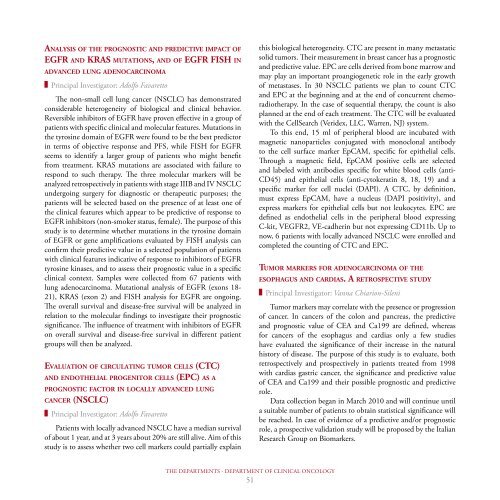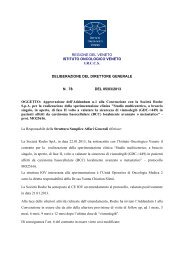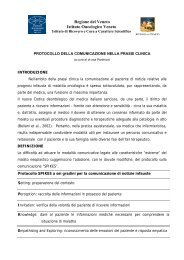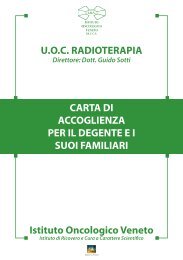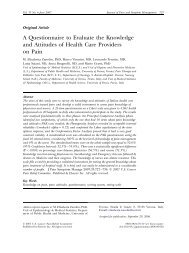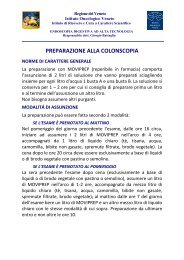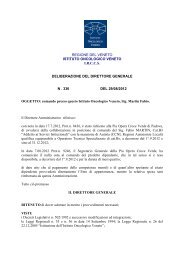SCIENTIFIC REPORT 2010 - 2011 - IOV
SCIENTIFIC REPORT 2010 - 2011 - IOV
SCIENTIFIC REPORT 2010 - 2011 - IOV
You also want an ePaper? Increase the reach of your titles
YUMPU automatically turns print PDFs into web optimized ePapers that Google loves.
aNalySiS Of ThE prOGNOSTiC aND prEDiCTivE impaCT Of<br />
EGfr aND kraS muTaTiONS, aND Of EGfr fiSh iN<br />
aDvaNCED luNG aDENOCarCiNOma<br />
Principal Investigator: Adolfo Favaretto<br />
The non-small cell lung cancer (NSCLC) has demonstrated<br />
considerable heterogeneity of biological and clinical behavior.<br />
Reversible inhibitors of EGFR have proven effective in a group of<br />
patients with specific clinical and molecular features. Mutations in<br />
the tyrosine domain of EGFR were found to be the best predictor<br />
in terms of objective response and PFS, while FISH for EGFR<br />
seems to identify a larger group of patients who might benefit<br />
from treatment. KRAS mutations are associated with failure to<br />
respond to such therapy. The three molecular markers will be<br />
analyzed retrospectively in patients with stage IIIB and IV NSCLC<br />
undergoing surgery for diagnostic or therapeutic purposes; the<br />
patients will be selected based on the presence of at least one of<br />
the clinical features which appear to be predictive of response to<br />
EGFR inhibitors (non-smoker status, female). The purpose of this<br />
study is to determine whether mutations in the tyrosine domain<br />
of EGFR or gene amplifications evaluated by FISH analysis can<br />
confirm their predictive value in a selected population of patients<br />
with clinical features indicative of response to inhibitors of EGFR<br />
tyrosine kinases, and to assess their prognostic value in a specific<br />
clinical context. Samples were collected from 67 patients with<br />
lung adenocarcinoma. Mutational analysis of EGFR (exons 18-<br />
21), KRAS (exon 2) and FISH analysis for EGFR are ongoing.<br />
The overall survival and disease-free survival will be analyzed in<br />
relation to the molecular findings to investigate their prognostic<br />
significance. The influence of treatment with inhibitors of EGFR<br />
on overall survival and disease-free survival in different patient<br />
groups will then be analyzed.<br />
EvaluaTiON Of CirCulaTiNG TumOr CEllS (CTC)<br />
aND ENDOThElial prOGENiTOr CEllS (EpC) aS a<br />
prOGNOSTiC faCTOr iN lOCally aDvaNCED luNG<br />
CaNCEr (NSClC)<br />
Principal Investigator: Adolfo Favaretto<br />
Patients with locally advanced NSCLC have a median survival<br />
of about 1 year, and at 3 years about 20% are still alive. Aim of this<br />
study is to assess whether two cell markers could partially explain<br />
THE DEPARTMENTS - DEPARTMENT OF CLINICAL ONCOLOGY<br />
51<br />
this biological heterogeneity. CTC are present in many metastatic<br />
solid tumors. Their measurement in breast cancer has a prognostic<br />
and predictive value. EPC are cells derived from bone marrow and<br />
may play an important proangiogenetic role in the early growth<br />
of metastases. In 30 NSCLC patients we plan to count CTC<br />
and EPC at the beginning and at the end of concurrent chemoradiotherapy.<br />
In the case of sequential therapy, the count is also<br />
planned at the end of each treatment. The CTC will be evaluated<br />
with the CellSearch (Veridex, LLC, Warren, NJ) system.<br />
To this end, 15 ml of peripheral blood are incubated with<br />
magnetic nanoparticles conjugated with monoclonal antibody<br />
to the cell surface marker EpCAM, specific for epithelial cells.<br />
Through a magnetic field, EpCAM positive cells are selected<br />
and labeled with antibodies specific for white blood cells (anti-<br />
CD45) and epithelial cells (anti-cytokeratin 8, 18, 19) and a<br />
specific marker for cell nuclei (DAPI). A CTC, by definition,<br />
must express EpCAM, have a nucleus (DAPI positivity), and<br />
express markers for epithelial cells but not leukocytes. EPC are<br />
defined as endothelial cells in the peripheral blood expressing<br />
C-kit, VEGFR2, VE-cadherin but not expressing CD11b. Up to<br />
now, 6 patients with locally advanced NSCLC were enrolled and<br />
completed the counting of CTC and EPC.<br />
TumOr markErS fOr aDENOCarCiNOma Of ThE<br />
ESOphaGuS aND CarDiaS. a rETrOSpECTivE STuDy<br />
Principal Investigator: Vanna Chiarion-Sileni<br />
Tumor markers may correlate with the presence or progression<br />
of cancer. In cancers of the colon and pancreas, the predictive<br />
and prognostic value of CEA and Ca199 are defined, whereas<br />
for cancers of the esophagus and cardias only a few studies<br />
have evaluated the significance of their increase in the natural<br />
history of disease. The purpose of this study is to evaluate, both<br />
retrospectively and prospectively in patients treated from 1998<br />
with cardias gastric cancer, the significance and predictive value<br />
of CEA and Ca199 and their possible prognostic and predictive<br />
role.<br />
Data collection began in March <strong>2010</strong> and will continue until<br />
a suitable number of patients to obtain statistical significance will<br />
be reached. In case of evidence of a predictive and/or prognostic<br />
role, a prospective validation study will be proposed by the Italian<br />
Research Group on Biomarkers.


